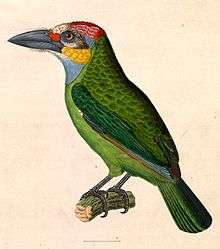Golden-whiskered barbet
| Golden-whiskered barbet | |
|---|---|
 | |
| Scientific classification | |
| Kingdom: | Animalia |
| Phylum: | Chordata |
| Class: | Aves |
| Order: | Piciformes |
| Family: | Megalaimidae |
| Genus: | Psilopogon |
| Species: | P. chrysopogon |
| Binomial name | |
| Psilopogon chrysopogon (Temminck, 1824) | |
| Synonyms | |
|
Megalaima chrysopogon | |
The golden-whiskered barbet (Psilopogon chrysopogon), a near passerine bird from Southeast Asia, is a species of Asian barbet.[2][3][4]
Description
At 24 to 30 centimeters in length and weighing from 110 to 181 grams, the golden-whiskered barbet is one of the largest of the sixteen species of barbets in Southeast Asia.[3][4] Their green overall plumage and yellow "whiskered" cheeks camouflages them amid the foliage they favor.[4] Genders are similar in appearance but do display a small degree of sexual dichromatism in that the beaks of female specimens appear paler and have a dusky bluish color. Before reaching maturity birds of both sexes have duller overall plumage.[3]
Habit and diet
This bird spends most of the day singing and foraging for food in the forest canopy.[3] Otherwise well camouflaged, their rapid and extraordinary loud "tehoop-tehoop-tehoop-tehoop" call often betrays their presence.[4]
Golden-whiskered barbets are frugivores that gorge themselves on berries, figs, and any edible fruits they can find.[3][4]
Reproduction
Breeding season for the golden-whiskered barbet is from February to August. Their rounded, white eggs are laid two per clutch.[3]
Range
The golden-whiskered barbet is found in Brunei, Indonesia, Malaysia, Thailand, Borneo and Sumatra.[2][3]
Habitat
Its natural habitats are subtropical or tropical moist lowland forest and subtropical or tropical moist montane forest.[2] They are found in lowland foothills and tall second growth forests but are rare in evergreen forests and swamp forests. The golden-whiskered barbet can also found be found on cocoa plantations.[3]
| Wikimedia Commons has media related to Megalaima chrysopogon. |
| Wikispecies has information related to Megalaima chrysopogon |

Subspecies
The following three subspecies of golden-whiskered barbet have been identified:[5]
- Psilopogon chrysopogon chrysopogon
- Psilopogon chrysopogon laeta
- Psilopogon chrysopogon chrysopsis
Other names
In Mandarin Chinese it is known as 金须拟䴕 (jīnxū nǐliè) "golden-whiskered false woodpecker" or 金颊拟啄木鸟 (jīn jiá nǐ-zhuómù-niǎo) or as "gold-cheeked false woodpecker". Its Japanese name is キホオゴシキドリ or 黄頬五色鳥 (kihō goshikidori), "yellow-cheeked five-coloured bird."[6] Bucco chrysopogon is a pseudonym.[5]
References
- ↑ BirdLife International (2012). "Psilopogon chrysopogon". IUCN Red List of Threatened Species. Version 2013.2. International Union for Conservation of Nature. Retrieved 26 November 2013.
- 1 2 3 Josep Del Hoyo (2002). Handbook of the Birds of the World, Vol. 7: Jacamars to Woodpeckers. Lynx Edicions. ISBN 84-87334-37-7.
- 1 2 3 4 5 6 7 8 "Megalaimidae (Asian Barbets)". Archived from the original on 2009-07-05. Retrieved 2009-02-25.
- 1 2 3 4 5 "Bird Ecology Study Group » Barbet, To'can, H'guide". Archived from the original on 2009-02-21. Retrieved 2009-02-25.
- 1 2 "Avibase: Gold-whiskered Barbet (Megalaima chrysopogon)". Retrieved 2009-02-25.
- ↑ "- Megalaimidae - 拟啄木鸟科 - ゴシキドリ科 - Họ Cu rốc -". Retrieved 2009-02-25.
